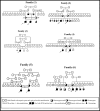Genotype and cardiac outcome in patients with cardiocutaneous syndrome (Naxos disease variant: Carvajal syndrome)
- PMID: 40108711
- PMCID: PMC11924745
- DOI: 10.1186/s13023-025-03612-8
Genotype and cardiac outcome in patients with cardiocutaneous syndrome (Naxos disease variant: Carvajal syndrome)
Abstract
Background: Naxos disease variant (Carvajal syndrome) is a cardiocutaneous genetic disease caused by Plakoglobin and Desmoplakin gene mutation, and usually manifests with woolly hair, palmoplantar keratoderma, and cardiomyopathy, and are found to have a high risk for uncontrolled arrhythmia.
Methods: An observational retrospective cohort study was conducted at King Faisal Specialist Hospital & Research Center in Riyadh, Saudi Arabia, a tertiary care hospital, which included 10 Saudi pediatric patients with clinical manifestations that indicate Naxos disease variant. The medical records of the patients were analyzed such as Echocardiography parameters (for ventricular function assessment), electrocardiography (ECG), 24-h Holter (for arrhythmias), and genetic analysis results were collected to confirm the medical diagnosis.
Result: We report 10 Saudi pediatric patients with Naxos disease variant who presented with severe dilated cardiomyopathy manifestation. All the patients had woolly hair, and half had palmoplantar keratoderma. They all had severely dilated and depressed left ventricular systolic function, and nine of them also had depressed right ventricular systolic function. Frequent premature ventricular tachycardias (PVCs) were reported in nine cases, and an implantable cardioverter defibrillator (ICD) was implanted in 3 patients for uncontrolled ventricular tachycardias. Moreover, four patients underwent heart transplantation, and three died suddenly while waiting for a heart donation. Finally, in 8 patients, genetic studies were homozygous for Desmoplakin gene (DSP), confirming the diagnosis.
Conclusion: Naxos disease variant is accompanied by high risk of arrhythmia and sudden cardiac deaths, so family members of proband need an extensive genetic workup for identification of gene carriers for counseling, especially in our Arab countries where consanguineous marriage is common. Moreover, hair and skin phenotypes in a child should alert for signs of cardiomyopathy manifestation.
Keywords: Carvajal syndrome; Naxos disease variant; Palmoplantar keratosis; Woolly hair.
© 2025. The Author(s).
Conflict of interest statement
Declarations. Ethics approval and consent to participate: This study has been approved by the Research Ethics Committee-Research Advisory Council (RAC), Riyadh (RAC #2211178). Consent for publication: Verbal informed consent was obtained from the legal guardians of all patients (to submit any details needed, including family pedigrees). Competing interests: The authors declare no conflicts of interest.
Figures
References
-
- Thiene G, Nava A, Corrado D, Rossi L, Pennelli N. The New England Journal of Medicine. Massachusetts Medical Society; 1988 [cited 2025 Jan 22]. Right Ventricular Cardiomyopathy and Sudden Death in Young People. Available from: https://www.nejm.org/doi/abs/10.1056/NEJM198801213180301 - PubMed
-
- Bukhari I, Jumaa N. Naxos disease in Saudi Arabia. J Eur Acad Dermatol Venereol. 2004;18(5):614–6. - PubMed
-
- Protonotarios N, Tsatsopoulou A. Naxos disease and Carvajal syndrome: Cardiocutaneous disorders that highlight the pathogenesis and broaden the spectrum of arrhythmogenic right ventricular cardiomyopathy. Cardiovasc Pathol. 2004;13(4):185–94. - PubMed
MeSH terms
Substances
Supplementary concepts
LinkOut - more resources
Full Text Sources
Medical
Miscellaneous



